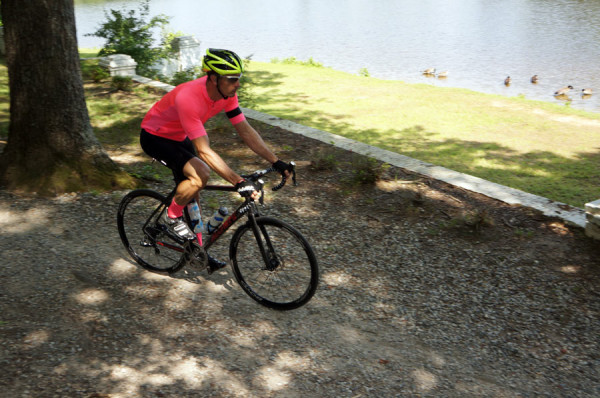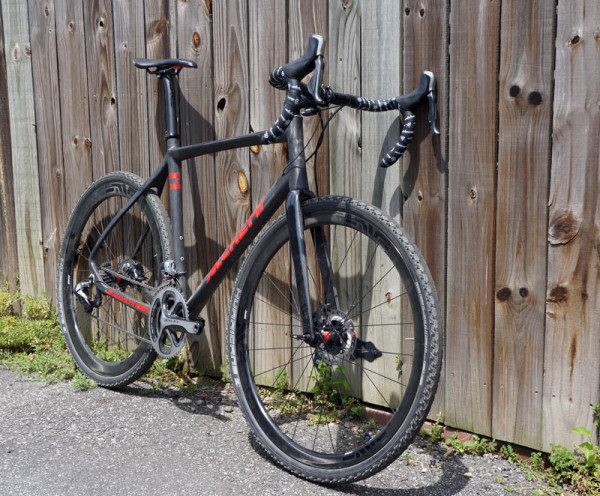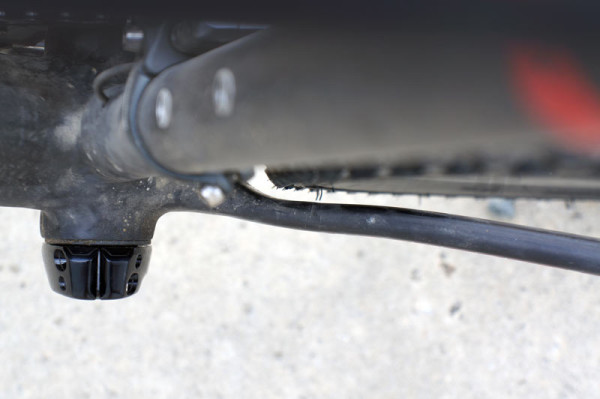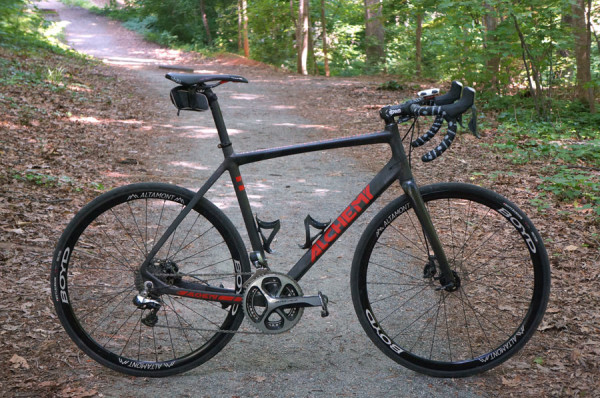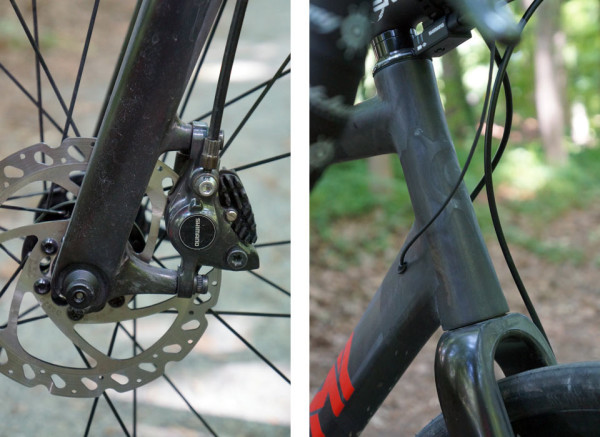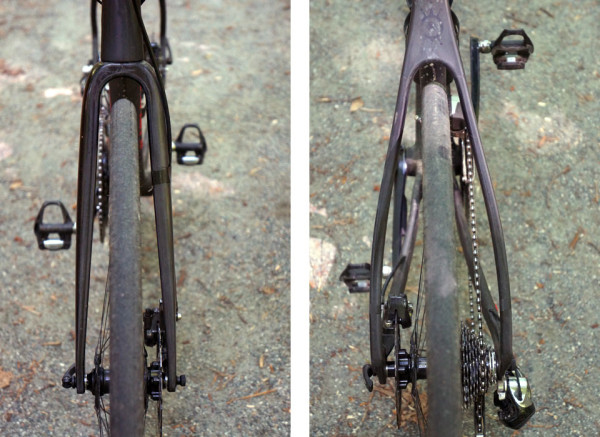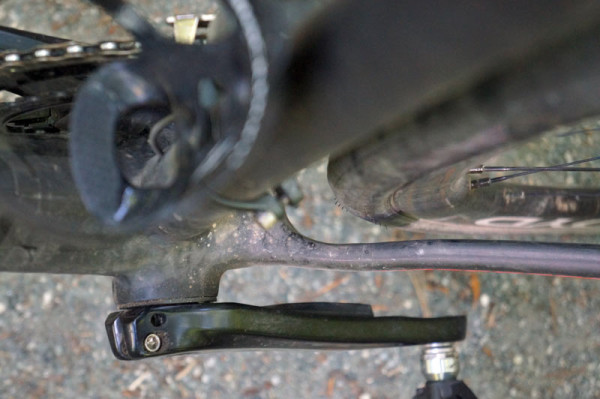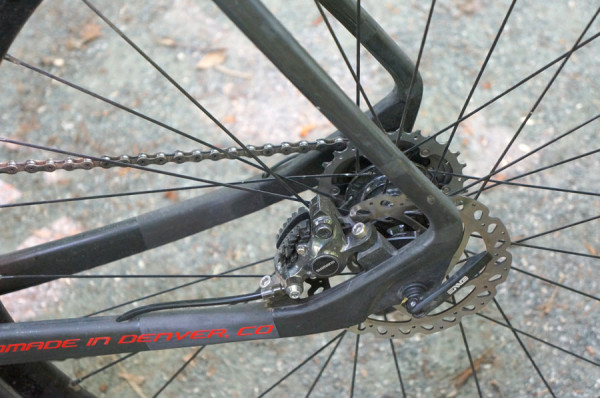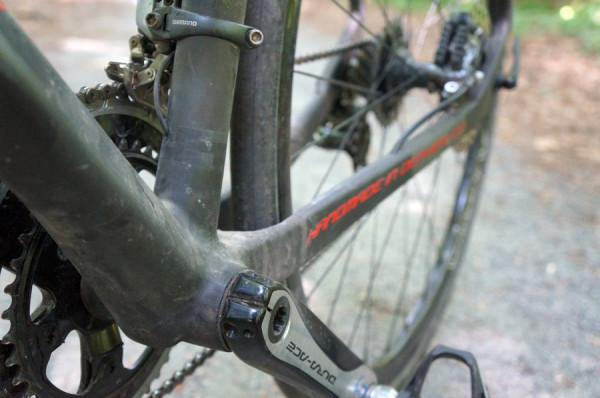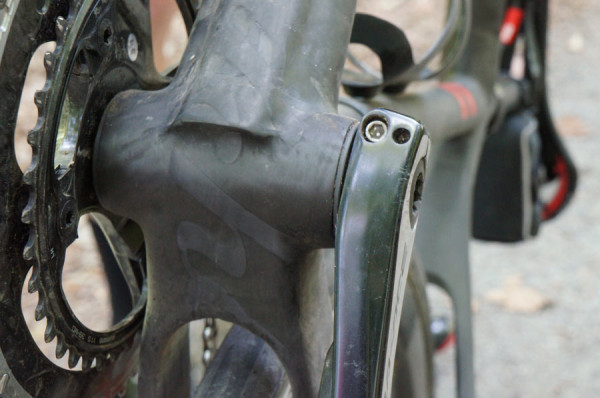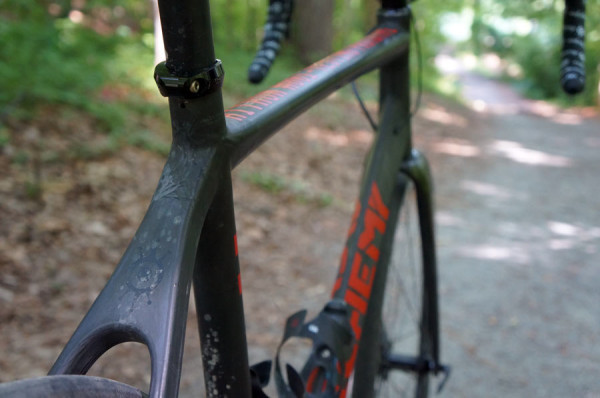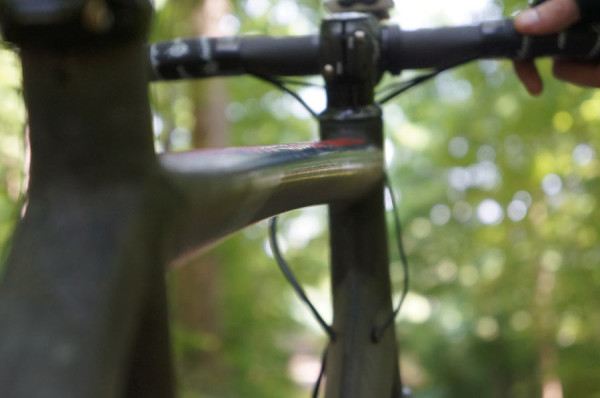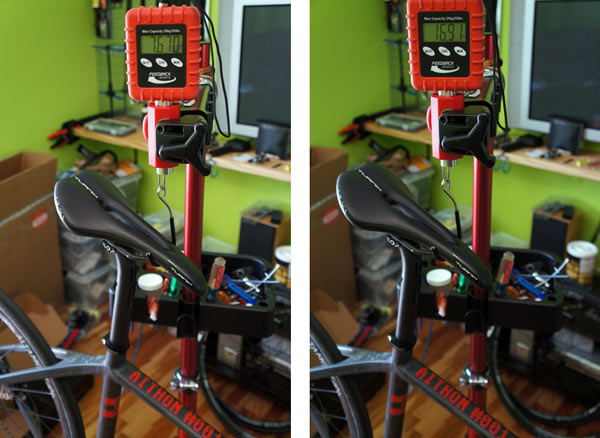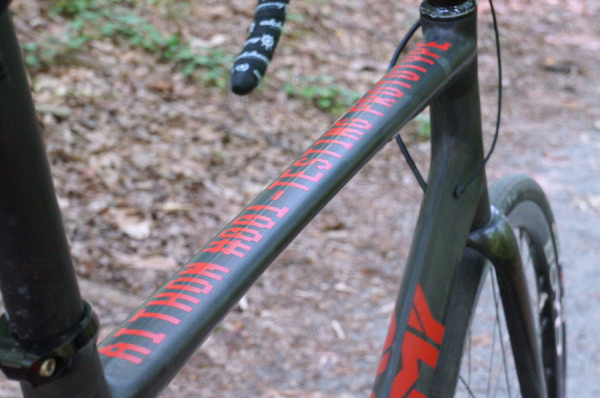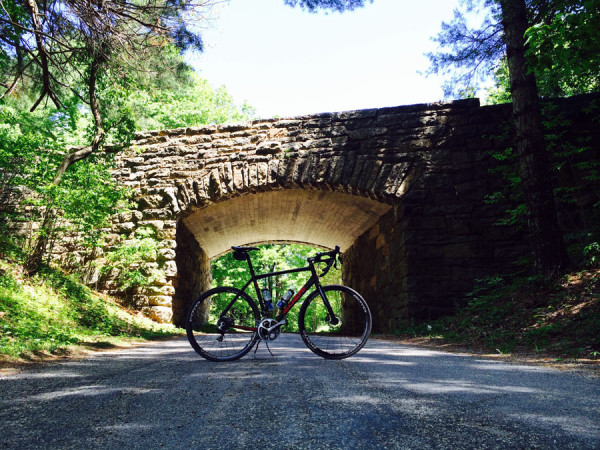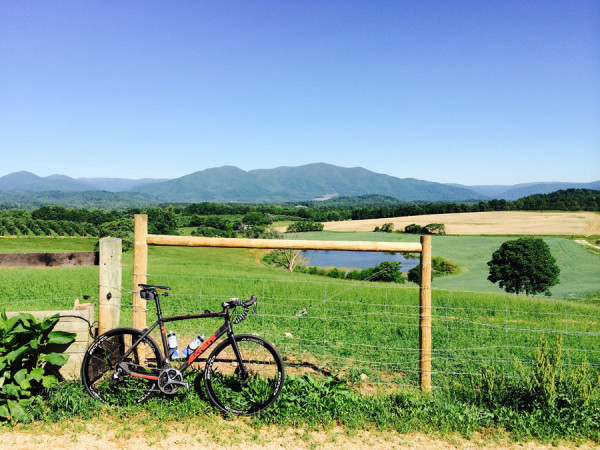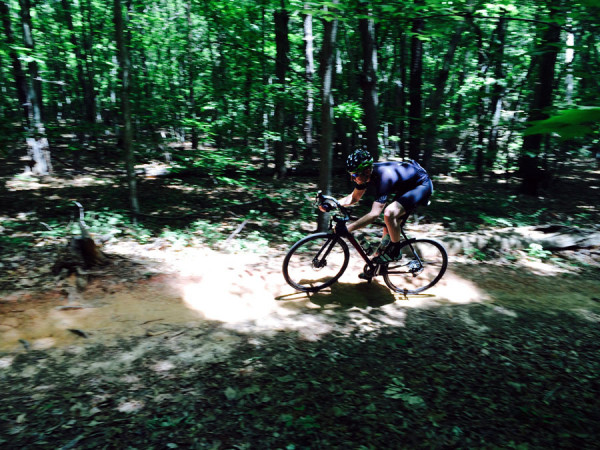After seeing the work of art that is the new Alchemy Aithon at NAHBS 2014, I asked co-founder Matt Maczuzak if I could borrow it for the Baller’s Ride. After all, you can’t just show up to a ride with top custom bike builders aboard anything stock, right?
After a quick yes from Matt and a couple of repeated assurances (at my behest) that the prototype everything was indeed safely rideable, it was shipped out and assembled for the big weekend. Turns out, the bike at the show was technically a non-rideable build meant only as a showpiece. The bike Matt shipped, which you see here, is the first rideable Aithon frame, which he says he was pretty happy that they seemed to nail it on the first build. The fork, which is their own design and the first they’ve ever made in house, is number prototype #004. Matt said the first one was mainly to get the shapes right, and #002 and #003 were too stiff. This one had the right blend of stiffness and forgiveness they wanted. To put my mind at ease, Matt (who’s taller and heavier than me..and I’m 6’2 / 190lb) said he’d been riding it for a while.
After a 20-ish mile test ride around town, I loaded it on the Inno Rack and headed north to Baller Camp…
This is how the bike arrived: Shimano Dura-Ace Di2 with hydraulic disc brakes (reviewed here), ENVE Smart Disc wheels shod in Schwalbe Hurricane 700×40 tires, ENVE bar, stem and seatpost, PRO saddle and Alchemy’s gravel fork.
As shown here, the complete bike weight (sans pedals) was 17.72lb.
My test ride and Baller’s Friday shakedown ride were ridden with these wheels and tires. I hit some gravel and dirt paths and plenty of pavement. The ride was comfy, and there’s enough clearance, but the heavier rotating stock simply wouldn’t do for an 80 mile ride with 8000+ feet of climbing. So, the new Boyd Altamonte Disc with Hutchinson Sector 700×28 were swapped in, set up tubeless with Stan’s tape and sealant. Here’s how I put most of my miles on it:
The Aithon marries Alchemy’s Helios road bike front end with an all-new rear triangle. All of it’s made in house.
It’s built with an 1-1/8″ to 1-1/4″ taper, which Matt says was the best balance of stiffness and ride quality.
The fork comes in at a claimed 430g for production models. It’s built around a 140mm rotor. A vibration damping material is laid up in the steerer tube, and it’s bladder molded as a single piece from tip to toe, nothing’s glued or bonded together. While the frames are full custom, the fork is built as a “stock” item with fixed sizing: 385mm axle-to-crown and 45mm rake. Yes, they’ll have a more elegant hose management than electrical tape on production models. The only other tweak I’d make is a bit of a support structure or rubber buffer between the rear brake hose and the frame port on the down tube. I could see the hose wearing over time as it flexes in the hole when steering. Maybe a plug at the top that allows some manner of zip tie to go on the hose inside the downtube to prevent it from rattling on the inside of the tube, too.
Clearance with 28c road tires is massive both front and rear.
Most carbon dropouts are pressed as solid carbon pieces that are then sleeved and bonded into the tubes. Alchemy’s new disc brake dropout sections are bladder molded to get the shape they wanted. It provides both clearance for inset brake mounts and adds leverage over the three-dimensionally bowed seatstays for better bump compliance.
The chainstays were plenty stiff enough to keep power transfer going where it should, but the whole thing works together to provide a very, very smooth ride.
Matt’s preference is PressFit BB86, but they’ll build with whatever you want. The channel for mechanical shift cables was left closed since this bike was made for Di2, but on customer bikes that want the option to run mechanical, the back face of the channel would be opened up and the appropriate stops put into place.
The Helios/Aithon front end ties into a round seat tube for a 31.6 seatpost. That the bike never felt harsh even with the larger diameter post is a testament to their layup and design.
The top- and downtubes are shaped to be aerodynamic and boost stiffness. Thankfully, this one wasn’t made as stiff as some of Matt’s other bikes I’ve ridden – it was just right in terms of lateral stiffness for stable, precise steering while presumably helping take the edge off the rough stuff.
With Boyd’s wheels, the bike came in at 16.91lb (7.67kg). Here’s the sizing and geo:
- HT 73 deg
- ST 73.5 deg
- HT length 190mm
- TT 575 mm
- CS 420 mm
- BB drop 70 mm
- ST C-C 520 mm
- Frame weight approx. 1,050g
They’re doing final independent lab testing as of this post going live at Act Lab. It undergoes fatigue and impact testing comparable to what’s required by CPSC and EN testing, even though custom frame builders aren’t subjected to the same regulations as mass production brands. Taking orders now, first ones will ship out around end of June. Retail is $5,500 for frame, fork and Chris King headset.
RIDE NOTES
For a ride like Baller’s, which is roughly (pun intended) 60% gravel and dirt, the Alchemy Aithon was perfect. Other than the minor cable/hose management items, I honestly have nothing to complain about. Which is doubly impressive since it’s a custom bike that wasn’t even built for me and it’s their first rideable prototype. I have a custom Helios that’ll be posted separately as a long term project bike soon, and it’s also a dream. Alchemy’s carbon bikes are simply amazing – Matt and crew really seem to know how to translate fit data and rider preferences and desires into a killer bike.
Do you need a dedicated high end gravel bike to get to places like these? No, and as the other baller’s bikes prove, a cyclocross bike will usually fit the bill. But if you want to do it in style and comfort, then the answer’s yes. After 80 miles on the big ride, I was so happy to have brought this. Off road, it handled supremely and confidently, even if I was power sliding into rubbly corners. On road, it behaved like a road bike. The slightly longer chainstays didn’t hamper climbing and probably aided descending. Even hard cornering was quick and responsive. Not crit racer quick, but for the vast, vast majority of normal riding, it’s perfectly fine.
Colin even borrowed it for a 30 mile road/path/singletrack ride and loved it.
I’d recommend it highly. The only reason I’m not heartbroken about sending it back so soon is that I’m already talking to Matt about building one up for keeps. Yes, the Helios is a killer road bike, but at $5,500 for the frame, most riders are looking for one custom road bike to last them a long, long time. And for that, I’d argue the Aithon is just the ticket. Other than thru-axles, it’s got all the latest, and it tackles a lot of terrain in one beautiful package.
Interested in their process? Their video runs through it with a nice soundtrack, and check out our factory tour for detailed photos and notes.
